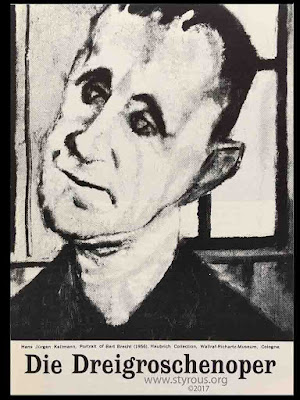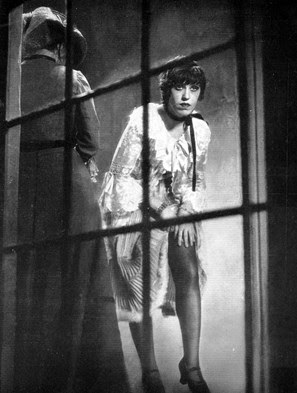Die Dreigoschenoper vinyl LP album cover sticker
On this date, August 31, in 1928, Die Dreigoschenoper (Threepenny Opera) premiered in Berlin at the Theater am Schiffbauerdamm.
This is an original cast recording of a performance in 1928 of that production which included Lotte Lenya (Jenny), Erika Helmke (Polly), Willy Trenk-Trebitsch (Macheath), Kurt Gerron (Moritatensänger; Brown), and Erich Ponto (Peachum). Lewis Ruth Band, conducted by Theo Mackeben.
The album cover is actually completely blank except for a sticker on the front with an image of a portrait by Hans Jürgen Kallmann of Bertolt Brecht. The sticker was mounted side wise and off-center for some reason.
The Threepenny Opera (Die Dreigroschenoper) is a "play with music" by Bertolt Brecht and Elisabeth Hauptmann, adapted from John Gay's 18th-century English ballad opera, The Beggar's Opera, with music by Kurt Weill and insertion ballads by François Villon and Rudyard Kipling. Although Hauptmann produced 80 to 90 percent of the text, Brecht suppressed this and assumed sole credit, and is usually listed as sole author in printed versions.
The album cover is actually completely blank except for a sticker on the front with an image of a portrait by Hans Jürgen Kallmann of Bertolt Brecht. The sticker was mounted side wise and off-center for some reason.
Die Dreigoschenoper vinyl LP album cover
with sticker of
Bertolt Brecht by Hans Jürgen Kallmann
photo by Styrous®
Die Dreigoschenoper vinyl LP album back cover
photo by Styrous®
with sticker of
Bertolt Brecht by Hans Jürgen Kallmann
photo by Styrous®
The back of the album is completely blank.
photo by Styrous®
The Threepenny Opera (Die Dreigroschenoper) is a "play with music" by Bertolt Brecht and Elisabeth Hauptmann, adapted from John Gay's 18th-century English ballad opera, The Beggar's Opera, with music by Kurt Weill and insertion ballads by François Villon and Rudyard Kipling. Although Hauptmann produced 80 to 90 percent of the text, Brecht suppressed this and assumed sole credit, and is usually listed as sole author in printed versions.
Die Dreigoschenoper (The Threepenny Opera)
German theater poster - 1928

premiere performance playbill
Theater am Schiffbauerdamm
Berlin, 31 August 1928
In 1931 a film of Die Dreigoschenoper (The Threepenny Opera) was produced. It was directed by
G. W. Pabst and produced by Seymour Nebenzal. It starred Rudolf Forster, Margo Lion, Carola Neher, Lotte Lenya and Reinhold Schünzel with the music of Kurt Weill (YouTube link below).
Die Dreigoschenoper (The Threepenny Opera)
movie poster - 1931
The film is loosely based on the 1928 musical theatre, The Threepenny Opera by Bertolt Brecht and Kurt Weill. As was usual in the early sound film era, Pabst also directed a French language version of the film, L'Opéra de quat'sous,
with some variation of plot details (the French title literally
translates as "the four penny opera"). A planned English version was not
made. The two existing versions were released by The Criterion Collection on home video.
Die Dreigoschenoper pamphlet (below) photograph
photo by Styrous®
Film director Georg Wilhelm Pabst (right) and actor Albert Préjean (as Mackie Messer) during the filming of L'Opéra de quat'sous (The Threepenny Opera) in 1931.
Albert Préjean (left), Georg Wilhelm Pabst (right)
Entartete Kunst
An entire room was devoted to the music of Kurt Weill, the main feature was this very recording of Die Dreigoschenoper which was played continually. However, it was removed after it attracted too large an audience.
Degenerate Art was the title of an exhibition, held by the Nazis in Munich in 1937, consisting of modernist artworks chaotically hung and accompanied by text labels deriding the art. Designed to inflame public opinion against modernism, the exhibition subsequently traveled to several other cities in Germany and Austria.
Degenerate Art Exhibition, Munich - 1937
Die Dreigoschenoper pamphlet front
Bertolt Brecht by Hans Jürgen Kallmann
photo by Styrous®
Die Dreigoschenoper pamphlet interior
photo by Styrous®
Die Dreigoschenoper pamphlet interior detail
detail photo by Styrous®
Die Dreigoschenoper pamphlet interior detail
detail photo by Styrous®
Die Dreigoschenoper pamphlet interior detail
detail photo by Styrous®
Blitzstein tells the story of his scandalizing his fellow students at Arnold Schoenberg’s Master class at the Berlin Hochschule, when he sat down at the piano and croaked out in bad German and a composers squeal, Mac the Knife and the jealousy duet just as Schoenberg entered the room. He gave this new music the name of misuk because it was different.
Mac the Knife has become a popular standard recorded by many artists, including a US and UK number one hit for Bobby Darin in 1959.
The records are still in their original glassine record sleeves.
Mac the Knife has become a popular standard recorded by many artists, including a US and UK number one hit for Bobby Darin in 1959.
The records
The records are still in their original glassine record sleeves.
Die Dreigoschenoper vinyl LP, side 1
photo by Styrous®
Die Dreigoschenoper vinyl LP label, side 1
photo by Styrous®
Die Dreigoschenoper vinyl LP, side 2
photo by Styrous®
Die Dreigoschenoper vinyl LP label, side 2
photo by Styrous®
Styrous® ~ Thursday, August 31, 2017


















No comments:
Post a Comment
PLEASE NOTE: comments are moderated BEFORE they are posted so DO NOT appear immediately.
Thank you.